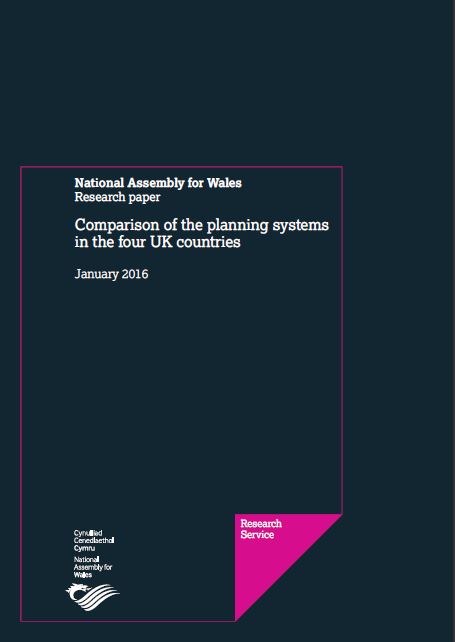Article by Graham Winter, National Assembly for Wales Research Service
We are today publishing a paper that describes and compares the land use  planning systems operating in Wales, England, Northern Ireland and Scotland. This is an updated and expanded version of the paper we first published in 2013. It has been prepared jointly by the National Assembly for Wales Research Service, the House of Commons Library, the Northern Ireland Assembly Research and Information Service and the Scottish Parliament Information Centre. All four countries have a planning system that can be described as ‘plan-led’. This means that national and local planning policy is set out in formal development plans which describe what developments should and should not get planning permission, how land should be protected and seeks to ensure a balance between development and environmental protection in the public interest. Decisions on individual planning applications are made on the basis of the policies in these plans, unless there are other considerations that need to be taken into account. Each country also has definitions of types of development that are permitted without the need for a planning application and defines “use classes” where change of use within a class is normally permitted. An appeal system to review decisions on applications also operates in each country, as is a system to enforce breaches of planning consent. Although the basic structures of the four systems are similar, there are some differences in how each system works. England, Northern Ireland, Scotland and Wales now each have their own primary planning legislation:
planning systems operating in Wales, England, Northern Ireland and Scotland. This is an updated and expanded version of the paper we first published in 2013. It has been prepared jointly by the National Assembly for Wales Research Service, the House of Commons Library, the Northern Ireland Assembly Research and Information Service and the Scottish Parliament Information Centre. All four countries have a planning system that can be described as ‘plan-led’. This means that national and local planning policy is set out in formal development plans which describe what developments should and should not get planning permission, how land should be protected and seeks to ensure a balance between development and environmental protection in the public interest. Decisions on individual planning applications are made on the basis of the policies in these plans, unless there are other considerations that need to be taken into account. Each country also has definitions of types of development that are permitted without the need for a planning application and defines “use classes” where change of use within a class is normally permitted. An appeal system to review decisions on applications also operates in each country, as is a system to enforce breaches of planning consent. Although the basic structures of the four systems are similar, there are some differences in how each system works. England, Northern Ireland, Scotland and Wales now each have their own primary planning legislation:
- The Planning (Wales) Act 2015 received Royal Assent in July 2015, although not all of its provisions are yet in force. This Act introduces new types of development plan and a new type of planning application to be decided directly by the Welsh Ministers;
- Changes in England since 2010 have seen a greater divergence from the other three countries. The Localism Act 2011 in particular provided the legal framework for the neighbourhood planning powers and the duty to cooperate with neighbouring authorities;
- The Town and Country Planning (Scotland) Act 1997 is the basis for the planning system in Scotland. This Act was substantially amended by the Planning etc. (Scotland) Act 2006. An independent review of the Scottish planning system is underway;
- The system in Northern Ireland has been changed significantly recently with the passing of planning functions to local Councils. On the 1st April 2015 a new two‑tier planning system came into force under the Planning Act (Northern Ireland) 2011.
For more information see our new publication.






